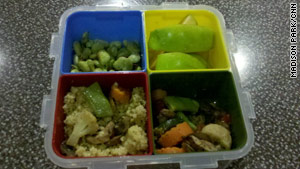The joy in eating comes from choosing what to munch on, based on how you feel.
But that “I-eat-whatever-I-feel-like” could mean overeating, mindless, emotional or unhealthy eating.
After a week of following MyPlate’s guidelines on a budget, I learned it takes a lot of planning and calculating. But it's possible.
For a week, I tweeted my meals on my Twitter account, @MadisonCNN. I planned my meals to ensure I had fruits, vegetables, lean protein, grains and low-fat dairy, while sticking to a weekly budget of $61.27.
I tried to eat out as I normally would, instead of eating all my meals at home ,which would’ve been unrealistic.
I ended up caving to a $3.72 frozen yogurt on the last day of the challenge. I was already 31 cents over budget, but the froyo pushed me way over. I didn't realize that until Sunday night.
Budget: $61.27
Final tally: $65.30
Final tally: $65.30
Here are my observations in bite-sized pieces:
1) MyPlate took me much longer to eat, because I had to finish various components.
One afternoon, my lunch took me two hours to finish because of meetings, interruptions and phone calls. I felt like I was eating all the time because it took me such a long time to finish.

The big difference was that I wasn’t eating fast, convenient foods that easily fit in my hands like a snack bar or a burger. So I ate at a much slower pace.
On Twitter, @soccer_jude asked, “So – are you finding your #myplate meals *sufficiently filling* that you're not feeling snacky in-between?”
When I got hungry, I snacked on mostly bananas, apples or grapes. But I also felt like I was constantly eating.
After a meal, I never felt hungry or uncomfortably full. Eating MyPlate slowed down my pace and made me more aware of how I felt after a meal.
2) It gets easier. Promise.
At first, the challenge seemed daunting.
The first two days, I felt hopeless – especially for a girl who seldom cooks and accidentally cracked a runny, underboiled egg against her table (messy).
I sought advice from foodie co-workers and sections like Cooking Light’s Budget Cooking that estimates how much each serving costs. I visited the grocery store three times in one week to price shop for the food I wanted.
Menu planning got easier as the week went by. There was some nice encouragement, including from CNNHealth contributor @AmandaEnayati who wrote, “I want to tell u that it gets easier with time & practice & also food gets yummier.”
3) Portion control is key.
Eating from the bento box ensured that I ate only what was in my container and didn’t go overboard on the portions. Having a visual cue helped me control how much I consumed.
On Twitter, @CliffWeightLoss asked: “Are you tracking any variables, such as weight, body fat %, or BP [blood pressure] during this experiment?”
I didn’t want this to be about calories or weight loss, but I had a doctor’s appointment three days before I started the challenge.
I lost 2 pounds by the end of the week and I wasn’t exercising any more than normal.
4) Your variables matter.
Eating to an ideal can be harder depending on where you live, access to stores/farmer markets, income, time constraints, food allergies or dietary restrictions.
Eating MyPlate might be difficult, but what’s the harm in trying?
Finally, I compiled the best affordable and healthy eating tips from blog readers and Tweeps:
Mollie: The expensive fruits & veggies are usually those that are out of season. Learning what types of fruits & veggies are in season when you go shopping is an easy way to cut costs. Also, if you find a great price on something fresh or you have grown an abundance, you can always blanch and freeze the extra.
Jennifer: I spend roughly $50/week for myself and my son and we eat a very healthy, well-balanced diet. It's possible to not spend a fortune, depending on your diet. We're not huge meat eaters but I buy extra when it's on sale. We eat seasonal fruits and veggies, don't buy a lot of prepackaged food (except things for bag lunches due to school rules), and don't buy a lot that doesn't get eaten.
Erin: I have found that it is possible to eat healthy, including fruits and vegetables and stay on a budget. When I go to the farmers market, I can get a big tub of organic spinach for $2. The grocery store sells that same tub for $6. That $2 allows me to have spinach salads all week for lunch. I also watch sales ads and watch for coupons (driscolls.com has berry coupons; Earthbound Farms will mail you coupons if you email them; Dole Pineapple puts out coupons every couple of months, etc). My husband and I eat healthy meals at home for $50/week including fruits, vegetables, fresh fish, and organic dairy products. Trust me, it can be done!
Thanks. And happy eating!












No comments:
Post a Comment